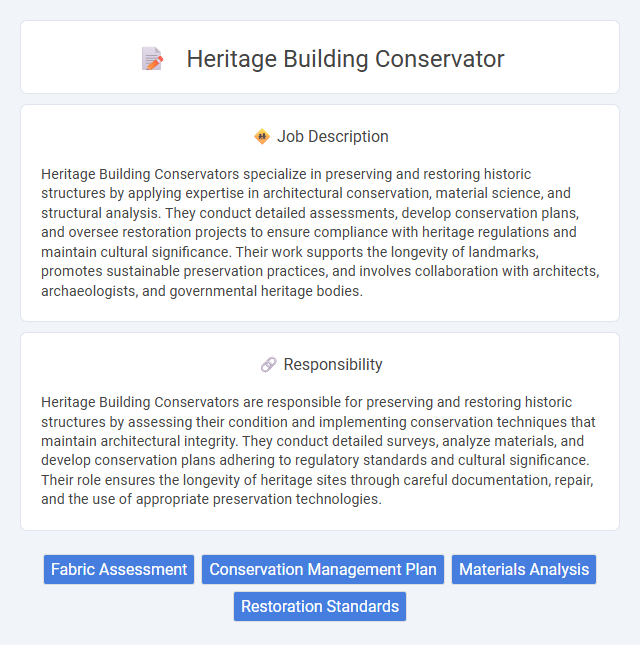
Heritage Building Conservators specialize in preserving and restoring historic structures by applying expertise in architectural conservation, material science, and structural analysis. They conduct detailed assessments, develop conservation plans, and oversee restoration projects to ensure compliance with heritage regulations and maintain cultural significance. Their work supports the longevity of landmarks, promotes sustainable preservation practices, and involves collaboration with architects, archaeologists, and governmental heritage bodies.
Individuals with a keen attention to detail and a passion for historical preservation may be well suited for a Heritage Building Conservator role. Those who find satisfaction in meticulous conservation work and can manage physically demanding tasks are likely to thrive. However, people who prefer fast-paced environments or have limited patience for long-term projects might find this job less compatible with their skills and interests.
Qualification
A Heritage Building Conservator must possess extensive knowledge of architectural history, materials science, and conservation techniques, typically supported by a degree in heritage conservation, architecture, or a related field. Proficiency in condition assessment, preservation planning, and material analysis is essential to effectively restore and maintain historic structures. Certification or specialized training in heritage conservation standards and the use of advanced diagnostic tools significantly enhances a candidate's qualifications.
Responsibility
Heritage Building Conservators are responsible for preserving and restoring historic structures by assessing their condition and implementing conservation techniques that maintain architectural integrity. They conduct detailed surveys, analyze materials, and develop conservation plans adhering to regulatory standards and cultural significance. Their role ensures the longevity of heritage sites through careful documentation, repair, and the use of appropriate preservation technologies.
Benefit
Heritage Building Conservator roles likely offer the benefit of preserving historical architecture, which may provide a strong sense of professional fulfillment and cultural contribution. The position probably includes opportunities for collaboration with experts in history, architecture, and conservation, enhancing interdisciplinary skills. Employment in this field might also come with access to specialized training and development, improving long-term career prospects.
Challenge
Working as a Heritage Building Conservator likely involves the challenge of balancing the preservation of historic authenticity with the adaptation to modern safety standards and materials. There is often a probability of encountering unforeseen structural issues that require innovative solutions to maintain the building's integrity. Navigating regulatory requirements while respecting the cultural significance of the site may also present complex difficulties in project execution.
Career Advancement
Heritage Building Conservators specialize in restoring and preserving historic structures using advanced techniques and materials, enhancing their value and longevity. Career advancement often involves gaining certifications in conservation science, project management, and heritage law, leading to roles such as Senior Conservator or Heritage Consultant. Professionals in this field can also expand into preservation planning, policy development, and academic research, elevating their influence on cultural heritage management.
Key Terms
Fabric Assessment
Heritage Building Conservators specialize in fabric assessment by meticulously evaluating the condition and composition of historic materials such as stone, wood, and mortar to guide preservation strategies. They use advanced diagnostic tools like moisture meters, infrared thermography, and microscopy to detect deterioration patterns and structural weaknesses. Accurate fabric assessment ensures that conservation efforts maintain the building's authenticity while preventing irreversible damage.
Conservation Management Plan
Heritage Building Conservators specialize in developing and implementing Conservation Management Plans (CMPs) to ensure the preservation and sustainable use of historic structures. CMPs provide a detailed framework for assessing the heritage significance, identifying conservation policies, and outlining maintenance strategies tailored to the building's unique fabric and cultural value. Expertise in heritage legislation, materials science, and architectural history is essential for creating effective CMPs that balance conservation requirements with contemporary needs.
Materials Analysis
Heritage Building Conservators specializing in materials analysis utilize advanced scientific techniques such as X-ray fluorescence (XRF), Fourier-transform infrared spectroscopy (FTIR), and microscopy to identify and characterize construction materials, including stone, mortar, wood, and metals. Their expertise enables the accurate assessment of material degradation, contamination, and previous restoration interventions, guiding appropriate conservation treatments and preservation strategies. Detailed materials analysis ensures the historical integrity and longevity of heritage structures through informed decision-making in conservation projects.
Restoration Standards
Heritage Building Conservators specialize in applying strict restoration standards to preserve the historical integrity and architectural authenticity of heritage structures. They utilize advanced techniques aligned with international conservation charters such as the Venice Charter and Burra Charter to ensure materials and methods are compatible with the original construction. Expertise in assessing deterioration, selecting appropriate conservation treatments, and maintaining compliance with local heritage regulations is crucial for successful restoration projects.
 kuljobs.com
kuljobs.com